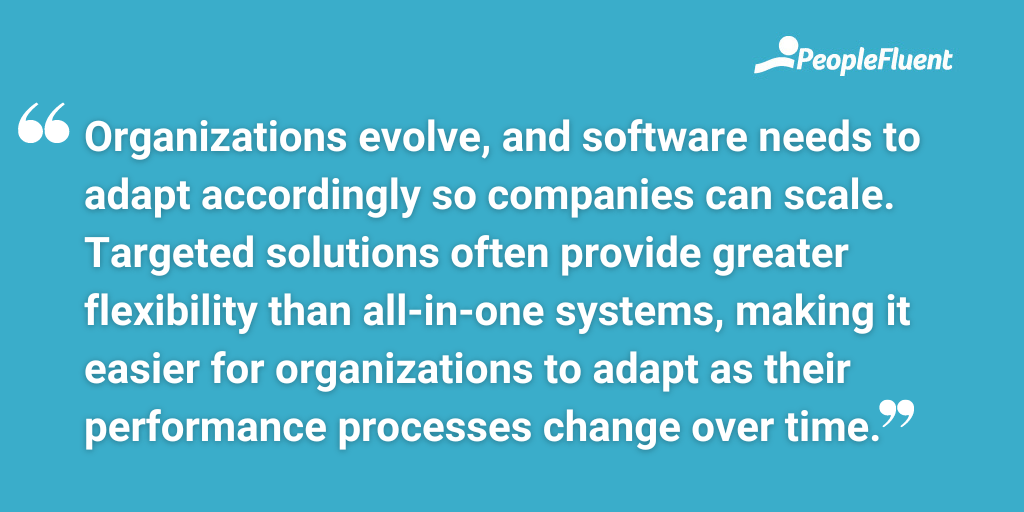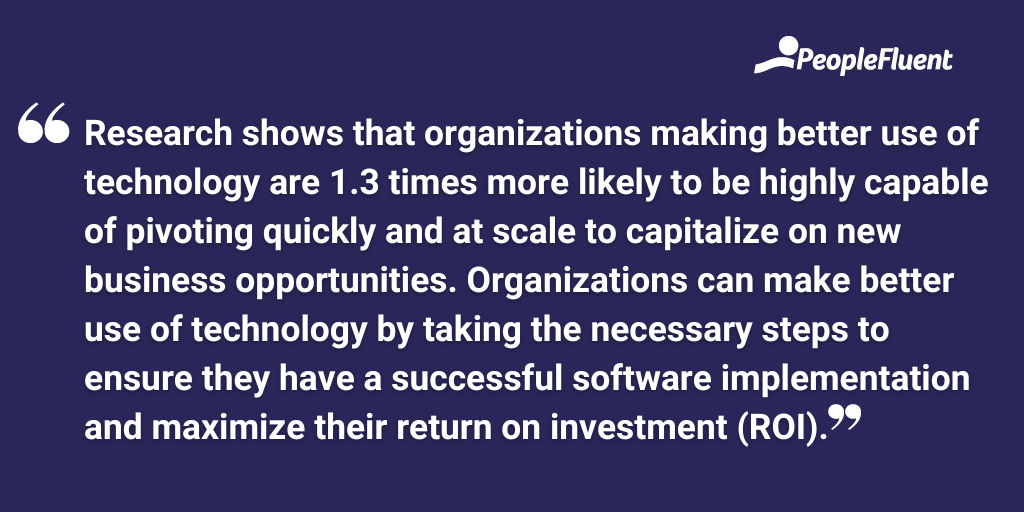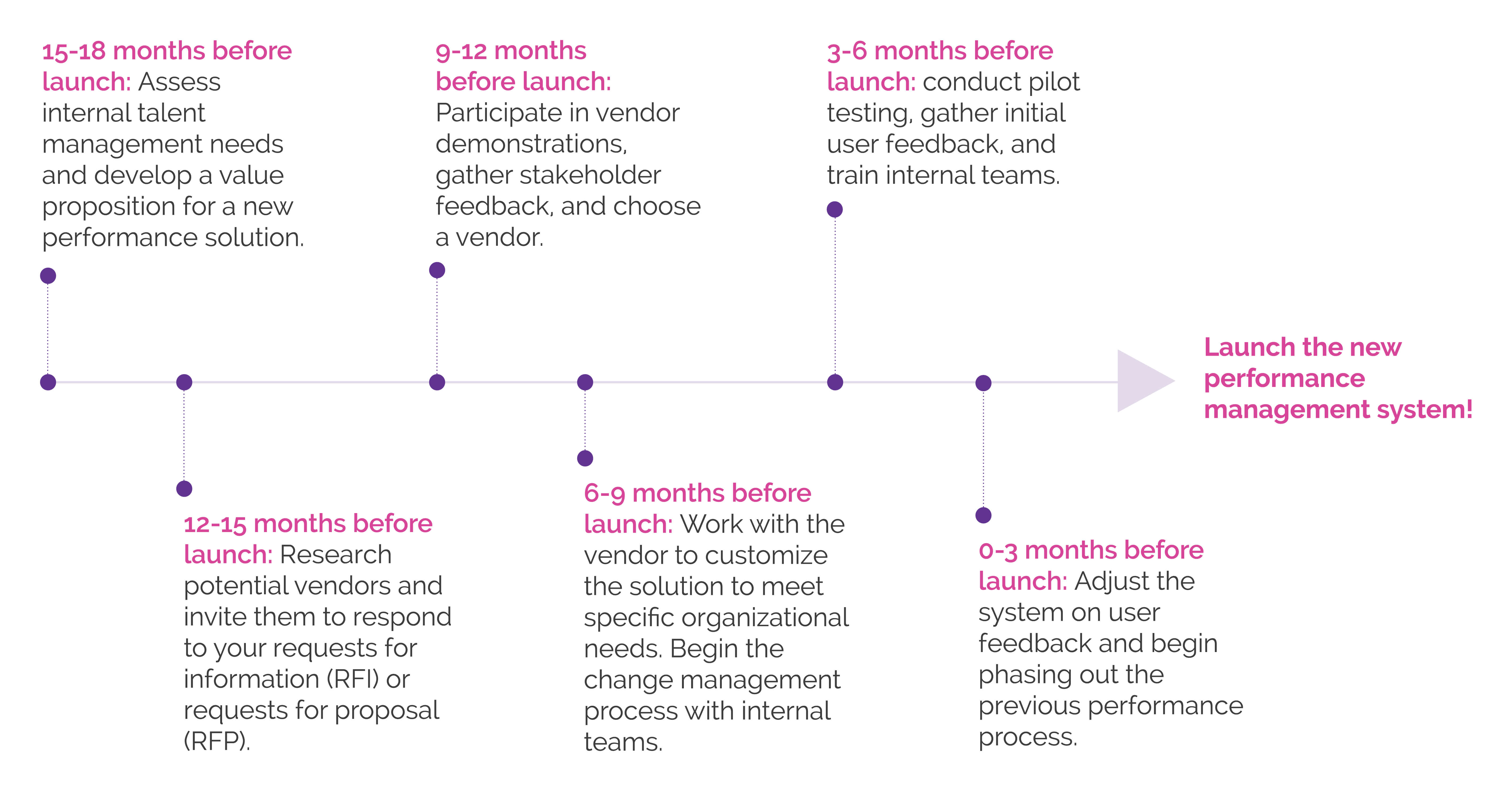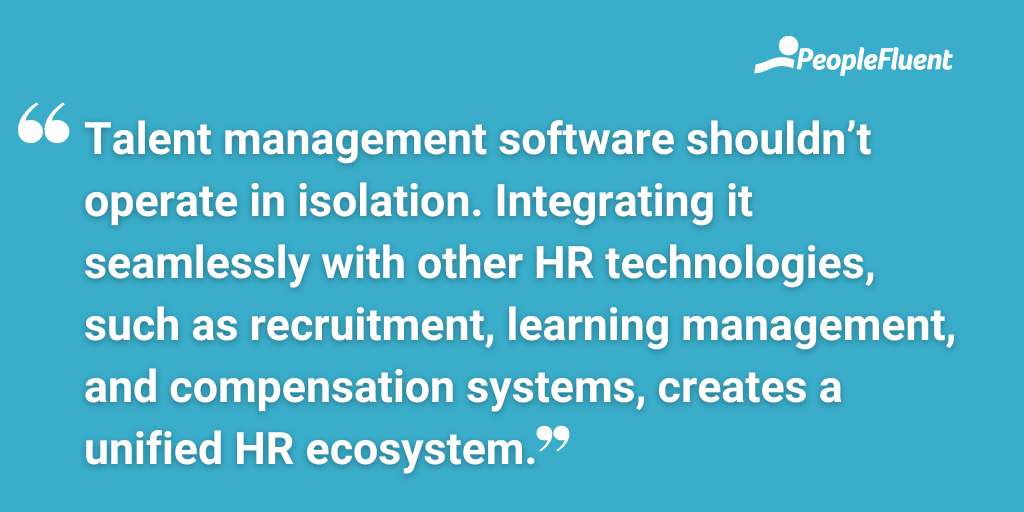Published: Feb 26, 2024Time to read: 9mins Category: Talent Management
How to Select the Right Talent Management Software (And Maximize Your HR Tech Investment)
The talent and performance management software you choose depends on your organization’s specific requirements. In this blog post, learn how to select the right solution for your business.
Deciding whether to implement an all-in-one HRIS or deploy targeted solutions, such as performance management or succession planning software, largely depends on an organization’s unique business needs. CHROs and talent leaders aiming to elevate their performance strategies must consider which tools can best address their pain points and suit their specific circumstances.
All-in-one solutions offer comprehensive HR functionality and streamline various processes under a single software umbrella. They often boast integrated modules for performance management, succession planning, and more, promising a holistic HR experience. That said, these systems might include unnecessary features for some organizations, leading to a steeper learning curve and potential inefficiencies. Additionally, updates or changes to one module can impact the entire system, posing challenges for customization.
On the other hand, solutions designed for specific HR functions like performance or succession planning provide a more targeted experience. Although all-in-one HRISs can accommodate succession, performance, and other HR needs, software that’s specifically designed to address a single HR function often provides greater flexibility, depth, and granular reporting. Performance planning software and other targeted solutions particularly benefit enterprise organizations with complex needs since these systems are capable of highly specific configurations. The more complex an organization’s processes are, the more likely it is that they’ll require very specific reporting features that aren’t widely available within all-in-one solutions.

READ MORE ABOUT HR SOFTWARE | ‘4 Hidden Pitfalls of an All-in-One HR Solution’
Consider Both Industry and Customization Needs
Not all talent management systems are created equal. Different solutions offer varying degrees of customization and available features, and some software is better suited for specific industries than others. Organizations need to choose a talent management solution that’s aligned with the unique needs of their industry.
For example, healthcare organizations need highly configurable software that emphasizes compliance, credentialing, and competency or clinical skill assessment to maintain their accreditation status and maintain compliance with regulatory agencies. Retail companies need talent software that can easily account for seasonal staffing changes and help leaders understand how employee performance metrics are tied to sales targets. Some solutions may lack the capabilities to handle highly complex or industry-specific needs, so it’s important to thoroughly research software options and how they assess the unique pain points in a specific market sector.
Additionally, flexibility and configurability are crucial. Organizations evolve, and software needs to adapt accordingly so companies can scale. Targeted solutions often provide greater flexibility than all-in-one systems, making it easier for organizations to adapt as their performance processes change over time. As organizations grow and new initiatives develop, highly configurable performance management software can be adapted to meet changing needs and ensure companies have the granular data necessary to make future-forward decisions.
Ask Vendors the Right Questions
Independent research will help HR leaders narrow down their list of potential vendors. Asking the right questions will ensure that they’re choosing the right software for their organizational needs and future goals. Talent management software is a major investment, so be specific and thoughtful about how the organization functions and what’s required of the software to achieve optimum results. Be sure to ask vendors the following questions:
- Can the software be customized to meet our industry-specific needs? Ask the vendor to provide case studies or specific examples of how they’ve assisted other organizations in your industry.
- How often do you release updates, and how disruptive are they to the current system? Discuss the potential impact that system updates will have on workflows and how the vendor minimizes disruptions.
- What level of training and support do you provide during implementation? The success of the software will depend on how confident employees are when they’re using it. Make sure the vendor will adequately support and train administrators.
- Is the system scalable to accommodate our organization's growth? Not all HR software will be able to scale with every organization’s growth. Learn how the vendor handles client growth and evolving needs.
- Can the solution integrate seamlessly with existing HR technologies? When choosing a targeted solution like performance management or succession planning software, determine whether the system is capable of importing data from your current technology tools. Robust solutions should be able to import data from existing systems with minimal complications.

LEARN MORE ABOUT IMPLEMENTING BUSINESS SOFTWARE | ‘3 Steps to Choosing the Right LMS in Highly Regulated Industries’
Understand the Implementation Timeline
There’s no standard timeline when it comes to implementing new performance software, but it’s important to be realistic. Companies just beginning to work on their value proposition won’t be going live with a new talent management tool next month. Searching for a vendor and implementing the product is a time-consuming endeavor. When your organization has more complex needs, you should reasonably expect to have longer implementation timelines. CHROs should work backwards with leadership teams to decide on an approximate go-live date. With that start date in mind, you can begin evaluating potential vendors capable of meeting the designated criteria by the desired go-live date.
It’s important to note that timelines will vary greatly depending on your organization’s unique circumstances. Below is a general example of an implementation timeline for performance management software:
- 15-18 months before launch: Assess internal talent management needs and develop a value proposition for a new performance solution.
- 12-15 months before launch: Research potential vendors and invite them to respond to your requests for information (RFI) or requests for proposal (RFP).
- 9-12 months before launch: Participate in vendor demonstrations, gather stakeholder feedback, and choose a vendor.
- 6-9 months before launch: Work with the vendor to customize the solution to meet specific organizational needs. Begin the change management process with internal teams.
- 3-6 months before launch: Conduct pilot testing, gather initial user feedback, and train internal teams.
- 0-3 months before launch: Adjust the system based on user feedback and begin phasing out the previous performance processes.
- Launch the new performance management system!

Remember to continuously gather and assess user feedback after launching the new software. Make adjustments as needed and continue to offer training and support as employees adjust to the new process.
4 Ways to Maximize Your Technology Investment
Once you've selected the perfect platform for your needs, you'll want to make the most of it. Research shows that organizations making better use of technology are 1.3 times more likely to be highly capable of pivoting quickly and at scale to capitalize on new business opportunities. Organizations can make better use of technology by taking the necessary steps to ensure they have a successful software implementation and maximize their return on investment (ROI). They must also have a thorough understanding of their mission, vision, and strategic objectives and align their performance software with these initiatives.
Implementing talent management technology means investing in future organizational success. Companies need to consider the following four strategies to maximize the ROI on their performance technology investments.
1) Encourage Continuous Training
The success of performance management software hinges on user engagement and proficiency. To maximize ROI, organizations should prioritize training for both managers and employees, ensuring they are adept at leveraging the system's features. Ongoing support and refresher training sessions can also contribute to sustained user adoption.
Additionally, organizations need to foster a culture of continuous learning. HR leaders can (and should) encourage users who have the appropriate permissions to explore the full capabilities of their performance software. When your software users are empowered to increase their understanding of its features and capabilities, they can leverage those features to deliver more effective performance appraisals and enhance talent management processes.

READ MORE ABOUT INTEGRATING TARGETED HR SOLUTIONS | ‘How to Gain a Competitive Edge With Compensation Technology’
2) Make Data-Driven Decisions
Talent management software gives organizations access to highly configurable reporting tools. Organizations should develop a data strategy that leverages those tools to extract valuable performance insights from their software. By analyzing performance metrics, identifying trends, and gaining a deeper understanding of employee capabilities, organizations can make data-backed decisions that align with business goals. Regularly reviewing and acting upon these insights ensures that the software becomes a strategic tool for driving organizational success.
3) Integrate With Other HR Technologies
Talent management software shouldn’t operate in isolation. Integrating it seamlessly with other HR technologies, such as recruitment, learning management, and compensation systems, creates a unified HR ecosystem. This process streamlines processes, reduces redundancy, and enhances the overall efficiency of HR operations. Additionally, it provides a holistic view of employee performance and development that can contribute to more comprehensive talent management strategies.
4) Perform Regular System Audits and Updates
Software updates are essential to keep pace with advancements and evolving organizational needs. Conducting regular system audits ensures that your talent software remains aligned with company goals and compliant with industry standards. Stay informed about updates and new features offered by the vendor, and implement them strategically to enhance your software's capabilities and maximize ROI.
Know Your Performance Needs and Take Your Time
Talent management solutions empower HR leaders to make strategic decisions and progress toward their goals. Regardless of your business objectives, performance software makes it easier to streamline processes and align organizational initiatives. Taking the time to properly research vendors and implement the right solution allows your enterprise to enhance employee performance while meeting—and exceeding—business goals.
Master Talent Management
Want more tips for optimizing your employees’ performance? Download our ebook, ‘Mastering Talent: Leveraging Technology to Transform Your Performance Strategy and Drive Employee Engagement,’ or request a PeopleFluent demo today to see our performance software in action.